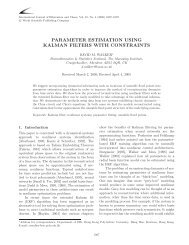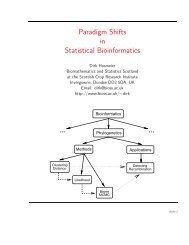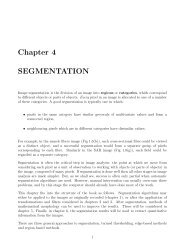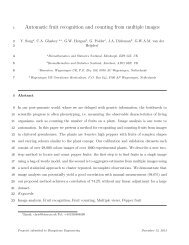Convergence of the Euler Scheme for a Class of Stochastic ...
Convergence of the Euler Scheme for a Class of Stochastic ...
Convergence of the Euler Scheme for a Class of Stochastic ...
Create successful ePaper yourself
Turn your PDF publications into a flip-book with our unique Google optimized e-Paper software.
<strong>for</strong> s ∈ [0, τ ∧ T 1 ]. Substituting (3.2), (3.3) and (3.4) into (3.1) <strong>the</strong>n reveals<br />
that<br />
[<br />
]<br />
E sup | x ∆t (t) − x(t) | 2<br />
0≤t≤τ∧T 1<br />
≤<br />
2K 1 (D)(T + 4) E<br />
= 2K 1 (D)(T + 4) E<br />
≤<br />
≤<br />
4K 1 (D)(T + 4) E<br />
4K 1 (D)(T + 4) E<br />
∫ τ∧T1<br />
0<br />
∫ τ∧T1<br />
0<br />
∫ τ∧T1<br />
0<br />
∫ τ∧T1<br />
∫ T1<br />
+4K 1 (D)(T + 4)<br />
0<br />
0<br />
E<br />
| ˆx ∆t (s) − x(s) | 2 ds<br />
| ˆx ∆t (s) − x ∆t (s) + x ∆t (s) − x(s) | 2 ds<br />
(<br />
| ˆx∆t (s) − x ∆t (s) | 2 + | x ∆t (s) − x(s) | 2) ds<br />
| ˆx ∆t (s) − x ∆t (s) | 2 ds<br />
[<br />
]<br />
sup | x ∆t (s ′ ) − x(s ′ ) | 2 ds. (3.5)<br />
0≤s ′ ≤τ∧s<br />
Bounding <strong>the</strong> first term on <strong>the</strong> right-hand side <strong>of</strong> (3.5) and <strong>the</strong>n applying<br />
<strong>the</strong> Gronwall inequality leads to a bound on E [ sup 0≤t≤τ∧T | x ∆t (t) − x(t) | 2] .<br />
Inspection <strong>of</strong> (2.4) reveals that ˆx ∆t (s) = x ∆t ([s/∆t]∆t) where [s/∆t] is <strong>the</strong><br />
integer part <strong>of</strong> s/∆t. We can now use (2.3) to show that<br />
| ˆx ∆t (s)−x ∆t (s)| 2 =|x ∆t ([s/∆t]∆t)−x ∆t (s)| 2<br />
= |<br />
∫ s<br />
[s/∆t]∆t<br />
f(x ∆t ([s/∆t]∆t))du +<br />
∫ s<br />
[s/∆t]∆t<br />
g(x ∆t ([s/∆t]∆t))dB(u)| 2<br />
≤ 2 |f(x ∆t ([s/∆t]∆t))| 2 ∆t 2 + 2|g(x ∆t ([s/∆t]∆t))| 2 |B(s) − B([s/∆t]∆t)| 2<br />
≤ 2K 2 (D)∆t 2 + 2K 2 (D) |B(s)−B([s/∆t]∆t)| 2 .<br />
Note that <strong>the</strong> last line follows provided s ∈ [0, τ ∧T 1 ] and condition (2.2) holds.<br />
If T ∆t < 1 this inequality leads to<br />
∫ τ∧T1<br />
E<br />
0<br />
| ˆx ∆t (s)−x ∆t (s)| 2 ds ≤ 2K 2 (D)T 1 ∆t 2<br />
≤<br />
∫ T1<br />
+2K 2 (D) E |B(s)−B([s/∆t]∆t)| 2 ds<br />
0<br />
2K 2 (D)T ∆t 2 + 2K 2 (D)T 1 m∆t<br />
≤ 2K 2 (D)(mT + 1)∆t (3.6)<br />
(recall that our Brownian motion has dimension m). Using this result in (3.5)<br />
shows that<br />
[<br />
]<br />
E sup |x ∆t (t)−x(t)| 2 ≤ C 1 (D)∆t<br />
0≤t≤τ∧T 1<br />
∫ [<br />
T1<br />
+ C 2 (D) E<br />
0<br />
]<br />
sup |x ∆t (r)−x(r)| 2 ds<br />
0≤r≤τ∧s















